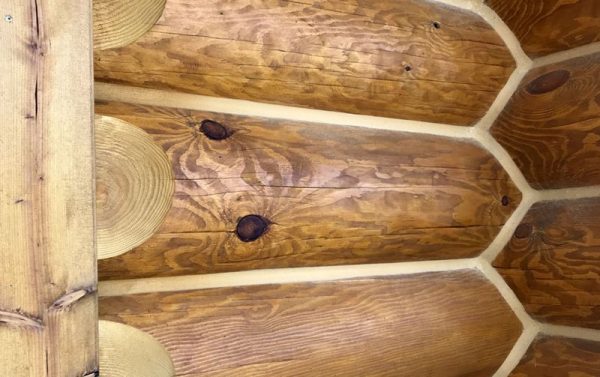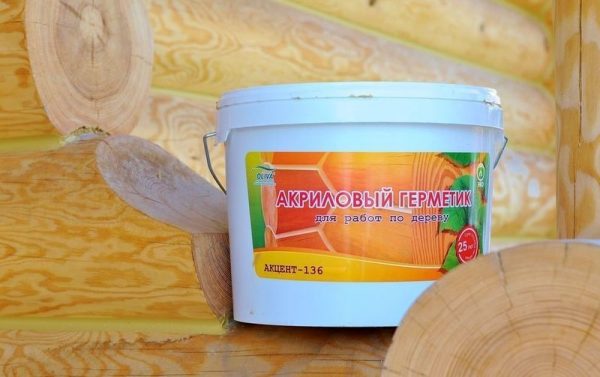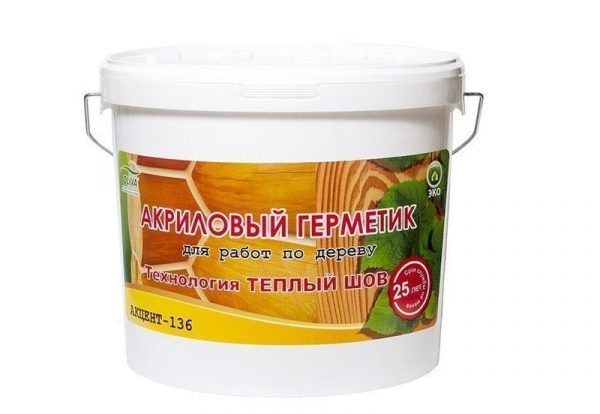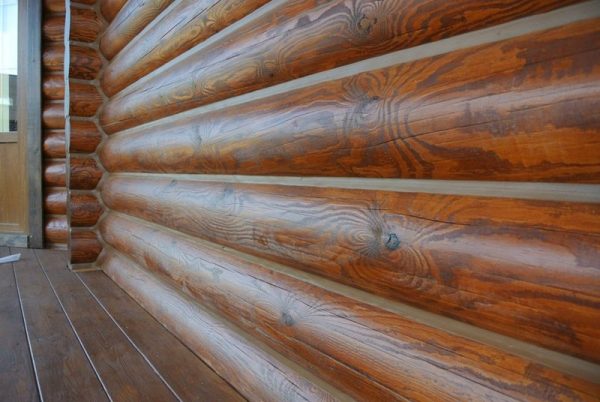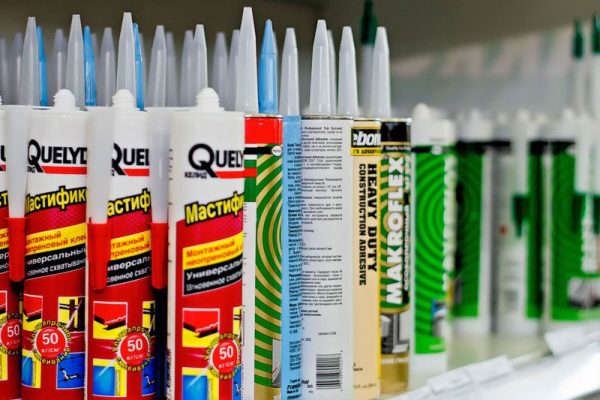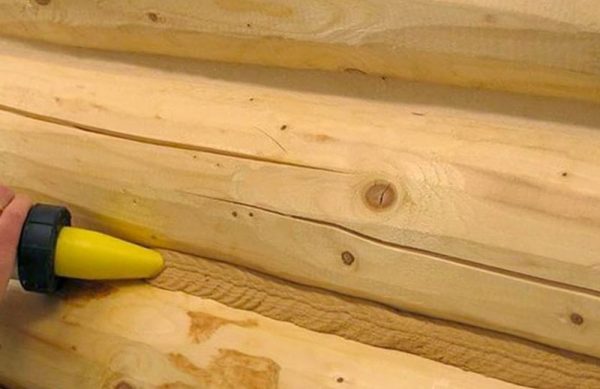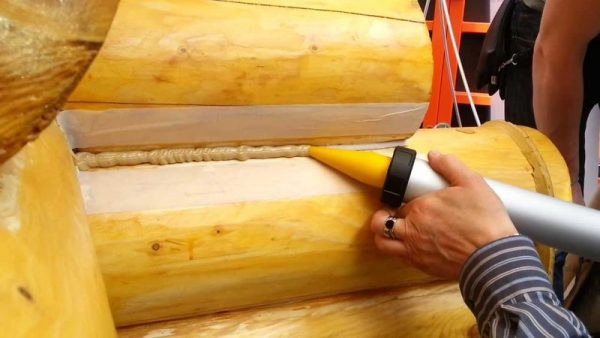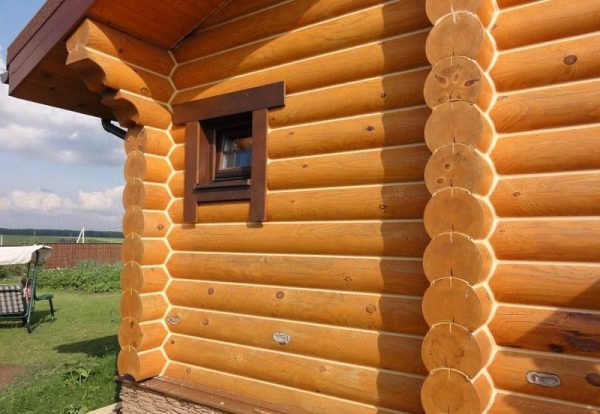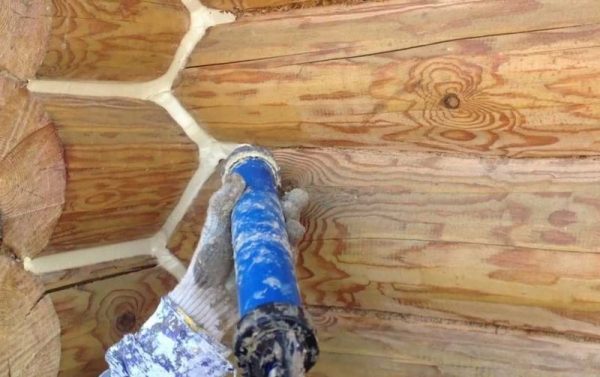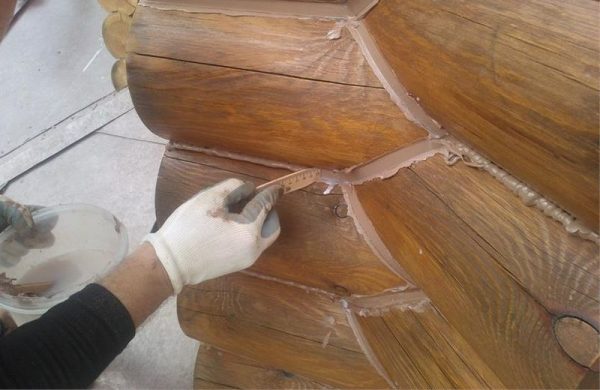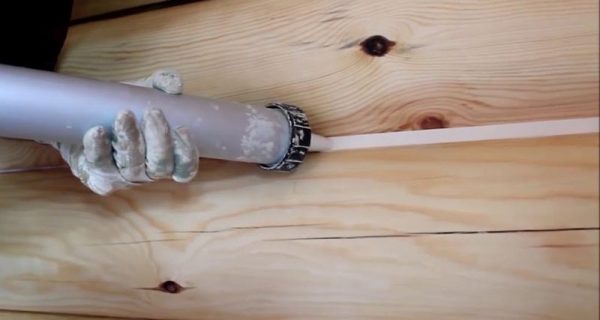Wooden buildings are affected by precipitation, temperature changes. After erection, the new tree shrinks, resulting in cracks and cracks. To prevent the deterioration of the microclimate in the room, the so-called warm seam for a wooden house is intended. The technology eliminates the disadvantages of natural wood and protects buildings from the cold.
- The essence of the technique
- Features of joint sealants for wood
- The choice of sealant for a warm seam
- Sealing Instructions
- Materials and Tools
- Training
- Sealing compound
- Material consumption
- Drying time
- Corners and cuts
- Sealant Storage Conditions
- Security measures
- Is it possible to do the sealing yourself?
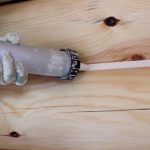
The essence of the technique
The joints between the logs in a wooden house require sealing, as are the joints in concrete, brick buildings. Nevertheless, the insulation process is very different from others and involves the use of other materials. Conventional building compounds will not last long, and during the shrinkage of the tree they can begin to crumble and collapse, and they will have to be changed quite often. But the sealant from the “warm seam” series works much more efficiently and is more reliable.
The “warm seam” technology is multi-stage and implies the following:
- first, the gaps between the logs, the bar are closed with any heat-insulating material;
- from above they seal the joint with a special cord, which will not allow insulation to contact the sealing compound;
- at the end of the work, a layer of warm seam is applied - a special sealant suitable for wood, based on acrylic, silicone or polyurethane.
Ready seam can be painted with any improvised materials. The joint will be strong, will not let moisture in and will prevent the house from blowing out. The sealant is rarely used in isolation, without additional caulking, because the gaps between the logs are quite large, and it can fall out when the material is displaced.
to contents ↑
Features of joint sealants for wood
Professional wood sealants are considered universal and highly effective products. They are great for creating warm seams in a log house, for filling gaps and holes in masonry, concrete, natural stone, suitable for work on gas and foam concrete, plastic, plastered surfaces.
Sealant “warm seam” 100% protects wooden buildings from wind, precipitation, temperature extremes. All products additionally contain antifungal additives that prevent mold from multiplying.
Properties and characteristics of sealants:
- safe for humans and the environment;
- suitable for outdoor and indoor use;
- have good elasticity (the elongation rate of some sealants can reach 700%);
- have a high degree of adhesion to wood and other building materials;
- Resistant to atmospheric factors and UV radiation;
- Do not suffer from yellowing, darkening over time.
Good sealants have the property of thixotropy. This means that they can be used without problems on vertical bases and inclined surfaces: they do not flow in a calm state.
to contents ↑The choice of sealant for a warm seam
The selection of means for sealing joints must be carried out with particular care.If you purchase a low-quality sealant for wood, there is a risk of wasting your energy and money on its use. When buying, you need to make sure that the product is really suitable for the "warm seam" technology and has excellent adhesion to wood.
Its service life in outdoor conditions should be 15–20 years or more, and shrinkage after drying should be absent or minimal. The good elasticity of the compounds, as well as the convenience of their application, are important: they must be produced in a tube that is ideally suited for the mounting gun.
Suture sealants are produced in a wide range. The safest and cheapest at the price are considered acrylic compositions. They are great for internal work because they are environmentally friendly, do not emit toxins, and do not contain solvents.
Acrylic quickly adheres to porous wood, and after polymerization can be painted like wood. For outdoor work, it is also suitable, but is considered less resistant to moisture, ultraviolet than other compounds.
Silicone sealants are also good for warm seams. They serve for 20–25 years, durable, flexible and reliable. Acid-based products are inexpensive, and those that are neutral (acid-free) boast higher adhesion to building materials.
Silicone has a few disadvantages. The dried seam cannot be painted, although ready-made tinted mixtures are on sale. It is not recommended to add pigments to the composition yourself - this is done only with the help of a special vacuum mixer.
Another type of “warm” sealants is polyurethane compounds. They have the following characteristics:
- optimum strength and adhesion to wood;
- tolerance of mechanical stress, moisture, the influence of chemicals;
- lack of shrinkage after drying;
- suitability for coloring as the polymerization of the seam;
- resistance to UV radiation;
- excellent elasticity, resistance to deformation.
Most polyurethane sealants contain solvents, so working with them is best outdoors. When choosing a product, it is worth giving preference to the compositions of well-known brands. Examples of good products:
- Neomid Wood Professional Plus - acrylic sealant, resilient, tear resistant, low flow;
- BARTONS "Warm House" - a silicone composition that does not shrink, contains a high concentration of fungicidal additives;
- Perma Chink - acrylic sealant with a quick setting, boasts strength and low consumption;
- Energy-Seal is an acrylic-based product suitable for processing joints up to 25 mm, easily tolerates deformations.
Sealing Instructions
High-quality warming of a wooden house is possible only with the exact observance of technology, which includes preparation and the main stage for filling cracks.
Materials and Tools
For work, you should buy a sealant in a cartridge or another form, which is well suited for a mounting gun. You also need to prepare:
- foamed polyethylene in the form of a cord;
- narrow spatula;
- paint brush;
- water
- a rag;
- masking tape;
- soil on wood;
- spray gun.
It is also possible to apply sealants manually, but using a gun will make work faster and more comfortable. In addition, the mounting gun helps to squeeze the product in a strictly dosed, smooth and beautiful strip, while without it it will be difficult to achieve such an effect.
to contents ↑Training
In older buildings, there is most often draft caulking. It is better to remove it to reduce the risk of mold, the appearance of insect nests. After the log house, they clean them of impurities, dust, remove the old paintwork, and, in the presence of oil impregnation, grind the base.
The wood is treated with degreasing compounds, then primed and allowed to dry well. If you ignore the preparatory measures, the sealant will lie unevenly, and its adhesion with the base will decrease.
Next, a special polyethylene cord is laid in the seams between the logs. It is designed to fill the interventional space, since it is completely expensive and inefficient to completely seal the entire gap.Joints that are too large are first caulked with jute, then a cord of foamed polyethylene is attached with metal staples. Both surfaces of the joints are pasted over with masking tape to make the sealant layer even.
to contents ↑Sealing compound
Means for creating a warm seam is applied using a mounting (glue) gun. You must act in this way:
- cut off the tip of the tube at an angle of 45 degrees;
- insert the tube into the gun;
- the product not packaged in cartridges should be poured into a special gun designed specifically for such sealants;
- press the “trigger”, applying sealant with an even tape of the required thickness (the layer of the product should capture the logs by 0.5–1 cm on both sides);
- sprinkle the seam with water from the spray gun, then level it with a spatula and remove excess;
- moisten a small brush, finish the joint;
- to remove stains, streaks with a rag, then remove masking tape, without waiting for the sealant to dry.
Typically, for complete polymerization, the sealing compound needs from 2-4 days to 2 weeks, depending on its type, brand, weather conditions. Only after the end of this period can the stitch be stained.
to contents ↑
Material consumption
Sealants are produced in tubes of 300 and 600 ml, as well as in plastic buckets of different volumes. Consumption varies greatly depending on the width and depth of the seam. For example, with a standard seam with a depth of 5 mm and a width of 20 mm per 1 running meter, 200–250 g of product will be spent.
Drying time
It is necessary to work with sealants using the “warm seam” technology in dry weather at a temperature within + 5 ... + 35 degrees. The optimum humidity for work is considered to be 60%, temperature + 20 ... 23 degrees. Under such conditions, the curing agent occurs at a speed of 2 mm / day, and the primary film appears after 30-60 minutes. In wet, rainy weather, a wooden house should not be sealed, as during snow. This will adversely affect the quality of the resulting seam.
to contents ↑Corners and cuts
The most difficult work on the formation of warm seams concerns the joints of wooden walls. To seal corners, cuts, put a polyethylene cord of the desired thickness and length into the slots, push it with a spatula. Usually this process takes a lot of time, is laborious and painstaking. After applying sealant, level its layer with a wet spatula.
to contents ↑If the corners were previously treated with oil impregnations or flame retardants, you will have to first grind the wood with a grinder, otherwise the sealant will not achieve the desired adhesion.
Sealant Storage Conditions
The product must be stored at a temperature within + 5 ... + 30 degrees without access to the sun, protecting it from moisture. The sealant can withstand up to 7 cycles of freezing and thawing (each lasting no more than a day, temperature - not lower than –18 degrees). Before use, the frozen composition is kept at room temperature for at least a day.
Security measures
Most wood sealants are fireproof, do not carry a risk of explosion, are non-toxic. Nevertheless, during work, it is necessary to protect the skin of the hands with gloves, to prevent the product from getting into the eyes, on the mucous membranes. When processing walls indoors, good ventilation should be provided.
to contents ↑Is it possible to do the sealing yourself?
The creation of warm seams is performed once for many years, therefore, it requires special care and strict adherence to technology. Non-professionals, beginners and those who ignore important rules often make mistakes that entail a serious decrease in the quality of the finished seam. The most common oversights are:
- improper selection of sealant;
- carrying out work in wet, cold weather;
- small thickness sutures;
- poor ground preparation;
- the implementation of rough, intermittent seams;
- poor-quality smoothing of joints.
If the technology is broken at any stage, the sealing layer may crack, burst or swell. This will cause depressurization and the entry of cold air inside the wooden house. Also, moisture will penetrate into the cracks, which will provoke rotting of the material and the appearance of mold, fungus.
The conclusion is: if you fully comply with the technology and acquire only high-quality compounds, the work can be done independently. In the absence of time, skills and desire, it is better to invite professionals to create warm seams. In this case, you don’t have to redo the work, which is even more costly and difficult, and the finished seams will serve faithfully for decades.

